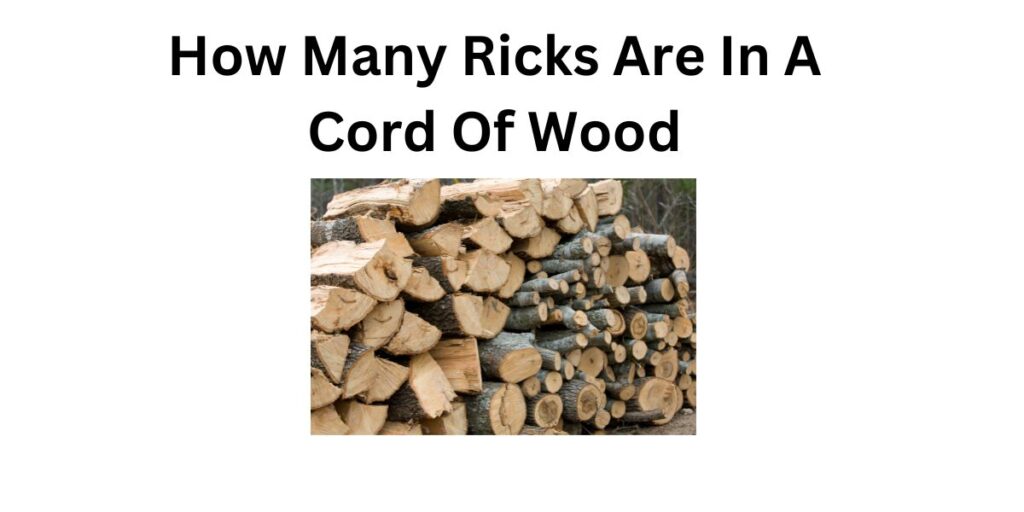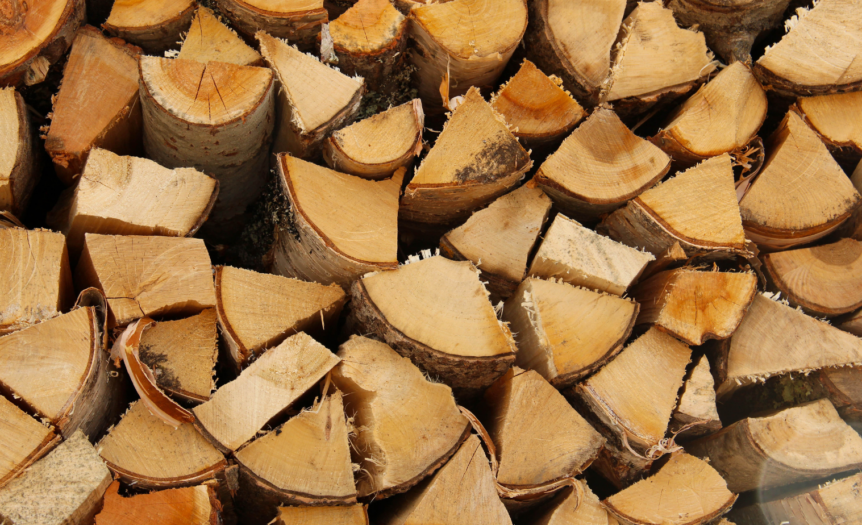Are you wondering how many ricks of wood are in a cord? Understanding firewood measurements can be tricky, especially when various terms like cords, face cords, and ricks come into play. But don’t worry! We’re here to help you understand these terms and make sure that you get the right amount of firewood for your needs. Keep reading to clarify the differences between these units of measurement and find out exactly how many ricks it takes to equal one full cord of wood!

Understanding Firewood Measurements: Cord, Face Cord, And Rick
In order to have a deeper understanding of firewood measurements, it’s important to know the definitions of a cord of wood, face cord of wood, and rick of wood.
Definition Of A Cord Of Wood
Understanding the term “cord of wood” is crucial when determining how many ricks are in a cord. A cord of wood is a common measurement used to describe a large quantity of firewood, typically used for heating homes or other spaces. This unit helps buyers and sellers make informed decisions about how much firewood they should purchase or sell.
A standard cord measures 4x4x8 feet, which comes out to be 128 cubic feet when it is neatly stacked. It consists mainly of wood itself but may also incorporate some air between logs if the stacking isn’t particularly tight. Buyers should note that this measurement can differ slightly based on the size and shape of the wood pieces as well as their arrangement within the stack. To get an idea of just how much space a full cord occupies, imagine around three transparent 4×8 foot sheets lined up side by side, totaling 16 feet in length – that’s how much room you’d need to store one full cord!
Definition Of A Face Cord Of Wood
A face cord of wood, also known as a rick in some regions like Arkansas and Kentucky, is another common firewood measurement. It refers to a single stack of split logs that typically measures 4 feet high and 8 feet long, with variable depth depending on the length of the logs. The depth can range from 16 inches up to 24 or more inches.
Unlike a full cord of wood which occupies 128 cubic feet (4x4x8), the volume of a face cord varies based on log length. For example, if your logs are cut at an average length of 16 inches (1.33ft) deep, your face cord would measure approximately 42.67 cubic feet (4×1.33×8). This means you would need around three face cords to equal one full cord of wood. Keep in mind that it’s essential to know not only the size but also other factors such as moisture content and quality when purchasing firewood for sale or estimating cost and quantity needed for heating purposes during those cold winter months!
Definition Of A Rick Of Wood
A rick of wood, also commonly known as a face cord or simply a stack, is an informal unit of measurement for firewood. This unit varies in size depending on the region where it’s being used, but generally refers to a pile of split logs that measures 4 feet high by 8 feet long. Unlike a cord of wood, which specifically represents 128 cubic feet in volume, there isn’t a set depth for a rick. The number of pieces in each rick can range from around 42 to over 300 logs.
In some regions such as Arkansas and Kentucky, people may utilize different terms or measurements when referring to ricks. For instance, they sometimes use half-ricks and quarter-ricks – which are units representing smaller quantities compared to the full-sized rick. Ultimately though this term remains flexible and might not have concrete specifications like those defining cords or other more standardized measurements. One thing remains unchanged: whether buying or selling firewood for heating purposes during winter months, having at least one well-stacked and seasoned “rick” is indispensable for many households across America’s countryside landscapes!
Factors Affecting The Number Of Ricks In A Cord Of Wood
The number of ricks in a cord of wood can be affected by several factors, including the quality of the wood, how well it is cut and split, and the moisture content.
Quality Of Wood
As a seasoned firewood enthusiast, I can attest that the quality of wood significantly impacts the number of ricks in a cord. Hardwoods such as oak and maple are denser and burn longer compared to softwoods like pine and cedar. This means that while a cord of hardwood produces more heat, it results in fewer ricks than an equivalent amount of softwood.
Another crucial factor is how well the wood is cut and split. The difference between neatly stacked logs versus haphazardly piled ones can mean squeezing one extra rick from the cord without compromising quality. It’s also essential to ensure that only properly seasoned wood makes its way into your stack since unseasoned or green wood has higher moisture content, which contributes to excessive smoke production, creosote buildup on chimneys or stove pipes, and lower heat output.
Choosing high-quality firewood requires knowledge about different tree species’ burning properties, log-splitting techniques, seasoning guidelines, among other factors. Therefore it’s critical always to source your firewood from reliable suppliers who know their craft inside out so you can enjoy efficient heating for longer periods without worrying about depletion or environmental sustainability issues associated with traditional fossil fuels.
How Well The Wood Is Cut And Split
When it comes to determining the number of ricks in a cord of wood, the way the wood is cut and split matters. Poorly cut or split firewood can result in more space between each log, which means you’ll need more ricks to fill up a full cord. On the other hand, well-cut and split firewood fits together like a puzzle piece, allowing for maximum stacking efficiency.
It’s essential to use proper techniques when cutting and splitting your firewood for optimal results. Using a sharp blade or axe helps make clean cuts without leaving behind any jagged edges that might prevent pieces from fitting snugly together. Additionally, taking into account the size of your stove or fireplace when splitting logs can help ensure that all pieces are uniform in length and width.
If you’re purchasing pre-split firewood from a supplier, be sure to ask about their methods for cutting and splitting as this can impact how much you get out of each delivery. Choosing high-quality, well-crafted firewood will save both time and money in the long run by reducing depletion rates while providing more heat per stack during cold winter nights.
Moisture Content Of The Wood
As you may already know, moisture content is a crucial factor when it comes to firewood. Wood that is fresh or green contains a high amount of water, which can affect its burning ability and also cause creosote buildup in chimneys. On the other hand, seasoned wood, which has been allowed to dry for at least six months, has lower moisture content and burns better.
It’s worth noting that the ideal moisture content for firewood is around 20%. In general, hardwoods like oak and hickory need longer seasoning times than softwoods like pine or spruce. To determine the moisture content of your firewood, you can use a simple tool called a moisture meter. This will give you an accurate reading so that you know whether your wood is ready to burn.
When buying firewood from a supplier, be sure to ask about the wood’s moisture content before making your purchase. Kiln-dried wood tends to have lower moisture levels than air-dried wood but may come with a higher price tag. Ultimately, investing in well-seasoned wood with optimal moisture levels will save you money in the long run by burning efficiently and reducing creosote buildup in your chimney.
How Many Ricks Of Wood Are In A Cord Of Wood?
To calculate how many ricks of wood are in a cord of wood, one must understand that a cord measures 4x4x8 feet or 128 cubic feet, and a typical rick is piled in a 4×8-foot stack, with each containing between 275 to 325 logs of firewood.
Calculation Of Ricks Of Wood In A Cord Of Wood
When calculating the number of ricks in a cord of wood, it’s important to keep in mind that the size of each rick may vary. However, on average, a standard rick measures 4×8 feet and is filled with about 42 to 64 pieces of firewood. Based on this measurement, there are typically between two and three ricks in a full cord of wood.
To get more specific with the calculation, you could count the number of pieces of firewood in a single rick and use that as your base. For example, let’s say you count 50 pieces per rick. To determine how many ricks are in a full cord (128 cubic feet), divide 128 by the volume taken up by one rick (32 cubic feet) which will give you four. Therefore, there should be around four or slightly less than four full-sized ricks found within one complete cord.
It’s worth noting that buying firewood by the individual “rick” can sometimes lead to confusion since these measurements are not standardized across all sellers. Therefore it’s always best to understand how many cubic feet or cords you need before purchasing any quantity from anyone for proper comparison on price points etc., especially when comparing between different regions like Arkansas versus Kentucky where demand varies wildly depending upon winter weather conditions often leading to fluctuating selling prices based off supply/demand affected depletion cycles within local forests over time etc..
Choosing The Right Amount Of Firewood For Your Needs
When choosing the amount of firewood you need, it is essential to consider several factors that will affect your decision. Firstly, you should estimate how much wood you’ll need for the winter based on your usage pattern and heating method. For those who rely solely on wood heat, a cord of wood may be enough to last a season. However, if you only use wood as supplemental heat or have mild winters in your area, half or even a quarter cord may suffice.
Secondly, it’s also necessary to ensure that the type and quality of the wood match your needs. Hardwoods such as oak and maple are denser than softwoods like pine and spruce; therefore burn slower but hotter. Kiln-dried woods have lower moisture content than air-dried logs hence burning cleaner with less smoke and ash residue.
Finally, always purchase firewood from reputable sources that can provide accurate measurements and descriptions about their products’ quality before making a purchase decision. The cost of firewood varies depending on location and market demand; however knowing how much you require makes budgeting easier while ensuring steady supply throughout the cold months.
Conclusion
Understanding the measurements of firewood is crucial for any wood-burning enthusiast. There are several terms to be familiar with, including cord, face cord, and rick.
A cord of wood measures 4x4x8 feet or 128 cubic feet, while a rick typically refers to a pile of wood measuring 4×8 feet. In general, a rick carries between 42 and 64 pieces of split and seasoned hardwood or softwood, which equals about one-third of a stacked cord.
The number of ricks in a cord may vary depending on several factors such as quality, moisture content, and how well the wood is cut and split. Remember these tips when purchasing firewood to get the right amount for your needs at an affordable price!








